The up-coming XENONnT experiment utilizes a total of 8.3 tonnes of xenon to search for the ever elusive dark matter particles. In addition to the existing 3.3 tonnes of ultra-pure xenon from XENON1T, another 5 tonnes of xenon were purchased by the XENON collaboration.
Before the new gas can be used for XENONnT, it needs to be purified. Besides oxygen, nitrogen and water that potentially absorb the light and charge signals in the detector, the radioactive noble gas Kr-85 within the xenon needs to be removed. Kr-85 is a man-made isotope created in nuclear bomb testing and nuclear fuel reprocessing. It makes up a fraction of 10-11 of the natural krypton (Kr-nat) abundance.
The commercially available xenon arrives with a Kr-nat in xenon concentration on the order of 10-6 (ppm, parts per million) to 10-9 (ppb, parts per billion) and needs to be purified down to a concentration of 0.1 x 10-12 (ppt, parts per trillion). To put this in relation: When purchased, an Olympic swimming pool filled with liquid xenon contains a 10 liter bucket of krypton. After purification, 200 Olympic swimming pools filled with liquid xenon contain together just one single droplet of krypton.
The purest xenon on Earth can be produced with the help of our Krypton Distillation Column located underground in the service building of XENON1T/nT as seen in the picture below. The purification method is based on the separation due to the different boiling points of xenon and krypton. While xenon is in its liquid form at -100°C, krypton, as the lighter atom, prefers to stay in its gaseous form. Like that, krypton is enriched at the top of our distillation tower from where it is removed and stored in a bottle as so-called “offgas”. The purified xenon can exit the distillation system at the bottom.

In total, over 100 bottles of freshly delivered xenon were installed in two bottle batches at the “Bottle rack”. Here, xenon samples from each batch were measured with a connected residual gas analyzer (RGA) system. Xenon from one of the bottle batches was continuously filled to the distillation system. Purified xenon was stored either to the Recovery and Storage for XENON1T (ReStoX-I) (left side of the picture) or to the ReStoX-II system (right side of picture), a newly installed subsystem for XENONnT. ReStoX-II is a system designed to rapidly recover and safely store up to 10 tonnes of xenon, that will serve as an fast recovery system during operation of the XENONnT experiment as well as xenon storage previous to the start of the experiment.
The full distillation campaign was split into three phases starting from April 2019 and was finished in July 2019. Xenon samples were extracted to measure the purified xenon purity at MPIK Heidelberg with a rare gas mass spectrometer.
As always in our collaboration, this operation too was an interplay between different groups: The bottle rack was installed by MPIK Heidelberg, the Distillation Column was operated by WWU Münster, and the ReStoX-I and -II systems were built and monitored by Columbia University in New York and Subatech-CNRS. The existing slowcontrol system was updated for the distillation campaigns by the Weizmann Institute of Science. Furthermore, local support was given by the group of INFN. Finally, to exchange bottles and to monitor the system 24/7, shifters from all over the collaboration supported the core distillation team.
